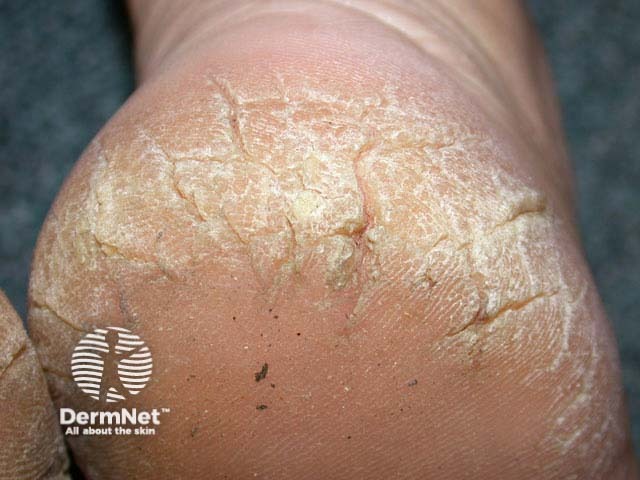Main menu
Common skin conditions

NEWS
Join DermNet PRO
Read more
Quick links
Mixed diagnoses – 10 cases (3 of 11)
For each of the ten cases, study the image(s) and then answer the questions. You can click on the image to view a larger version if required.
Each case should take approximately five minutes to complete. There is a list of suggested further reading material at the end of the quiz.
When you finish the quiz, you can download a certificate.
Case 8

What skin disorders predispose to fissures?
The fissures arise because of plantar hyperkeratosis or localised keratoderma. Palmoplantar keratoderma may be hereditary or acquired, localised to the hands and feet or part of a more generalised skin disorder.
There are many rather rare syndromes that cause severe diffuse keratoderma, but it is relatively common to present with keratoderma localised to pressure areas (callosities). It is particularly troublesome in obese individuals.
Keratoderma is associated with various forms of eczema (when it tends to be pruritic), psoriasis (look for erythema and well-defined margin), and other skin diseases. It is a common feature of myxoedema due to hypothyroidism. Arsenic poisoning and several drugs (mainly antimalarials and cytotoxic agents) may induce keratoderma. It may be confused with dermatophyte infection 'moccasin tinea' and mosaic plantar warts.
The onset of plantar hyperkeratosis in the 40s is known as keratoderma climactericum. It can become very extensive and also affect the centre of the palms.
What treatment is available?
Therapeutic options only result in short-term improvement and are symptomatic.
The patient should be advised to wear well-fitting shoes and socks to reduce friction, and may find it helpful to soak the feet in warm salty or oily water (mix emulsifying water with hot water in a jug and pour into a foot bath).
Fissures are generally less painful if occluded. Hydrocolloid dressings and skin adhesives such as nail glue or Liquid Bandage™ are convenient.
Topical keratolytics include 5-10% salicylic acid, 10% lactic acid, or 10-25% urea in a thick emollient base, such white soft paraffin; there are several effective commercial heel balms.
Topical retinoids, such as tretinoin (0.01% gel and 0.1% cream), are effective, but treatment is often limited by skin irritation.
Consider a potent topical steroid with a keratolytic (Diprosalic™ ointment) if the dermatosis has an inflammatory component i.e. it is red and itchy. Prescribe a two to four-week course or use as pulse therapy to reduce tachyphylaxis.
Acitretin is effective for severe keratoderma but adverse effects limit its usefulness.
